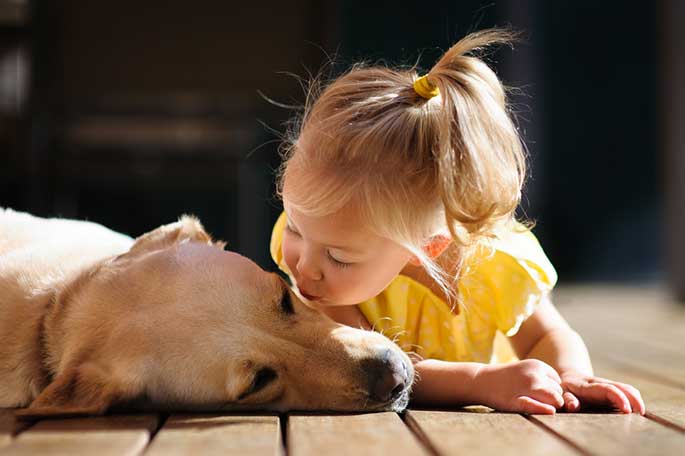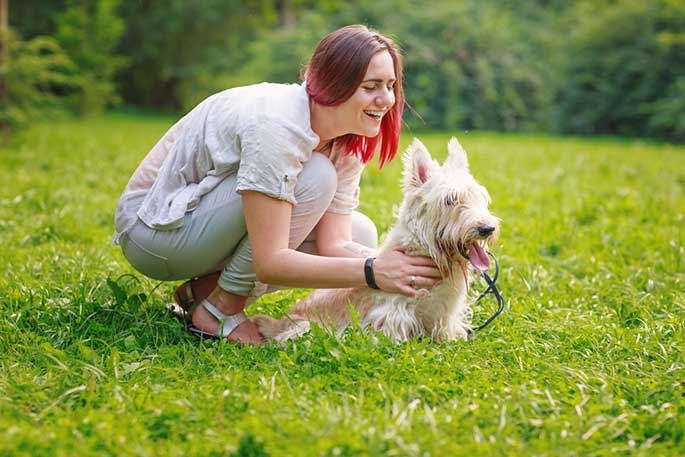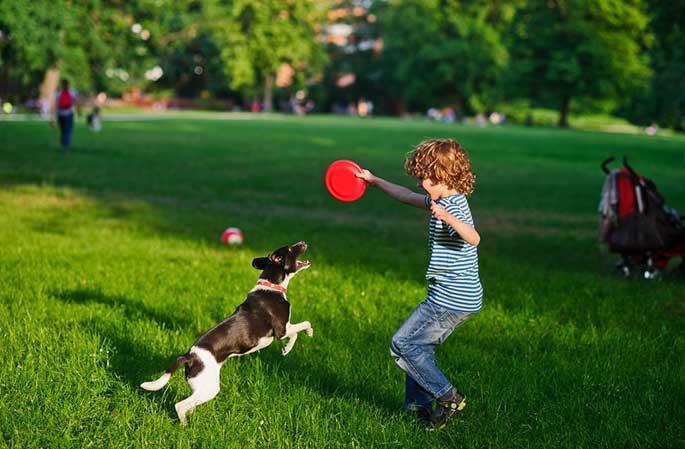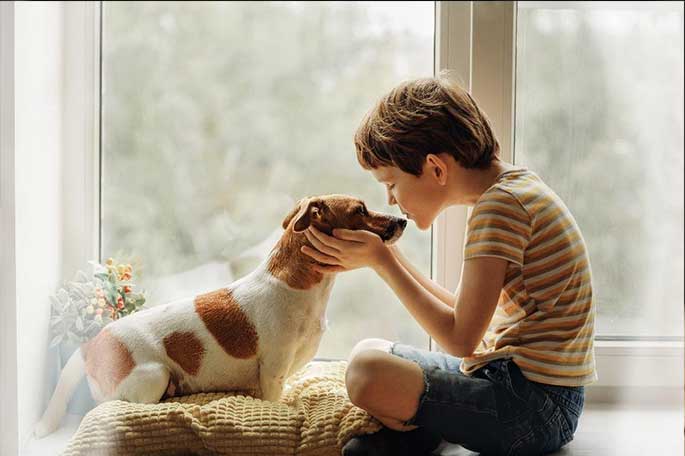
Adding a canine companion to your household is one of the most rewarding and amazing things you can do. Studies show children who grow up with pets show more compassion, understanding, responsibility, and even motivation. It also helps develop social skills and emotional intelligence as they help you care for an animal who loves unconditionally.
But if you’re considering getting a dog with small children in the house, there are some things to consider. Dogs and kids can be very similar and they will both need to be taught how to interact with each other. Not only will you need to train your pet, but your children will also need some ‘training’ to understand the complexities of another animal, and you’ll need to keep a watchful eye out to ensure playtime is always safe and fun for all parties involved.
Before committing to providing a forever home to your new best friend, check out our top tips for helping both your kids and your pup adapt to their new environment.
Remember, moving home is stressful enough for humans, and for a dog, it’s even more so as they don’t understand what’s happening! Lots of patience and understanding are essential for helping your new pup adapt, and you’ll need to be confident that your children are on board before starting the process.
Here are a few tips for adopting a dog when you have young children!
1. Involve your children in the conversation
While it might be tempting to surprise your children with a puppy on Christmas morning or another special occasion, doing this takes away your kids’ ability to prepare for the responsibility that having a pet involves.
We know that most children are relentless in their “can we get a puppy?!” requests, but be aware that not all children are well suited to having a pet in their lives. If your kids are frightened of dogs or have had little to no experience being around them, you might want to consider introducing your children to the dogs of friends and family before bringing one into your home.
Try going through a list of tips for adopting a dog with them. This will help them have a better idea of what to expect with your new pet. After all, even adults often don’t fully understand what they are getting into when they adopt a pet.
It’s important to understand that dogs can sense when people are nervous around them, which goes for children too! The heightened anxiety can cause your pup to feel nervous as well, which can make them less predictable and more likely to lash out in fear. This is particularly important to understand when rescuing a pup, as they may not have had the loving home you intend to provide them with in the past.
2. Explain their responsibilities
You don’t want to have to be 100% responsible for a household full of tearaway children and an excitable puppy. So, let your children take their share of responsibility for the family pet.
Before you even consider adopting a pup, it’s a good idea to have a long conversation with your children about what owning a dog entails and set out their responsibilities early on.
It can be beneficial for multi-children households to create a schedule that allows everyone to share playtime and responsibilities fairly. This can prevent your new companion from getting overwhelmed when everyone wants to play at once and also clearly sets out who’s on toilet duty when the novelty runs out.
Older children can also get involved in walks and may even be able to take the pup with them on short adventures. Being sure to clearly explain the parameters of this and that they will be expected to share in the dog walking (even on rainy days) can help prevent issues arising later on!
It is also important that when you are deciding what to look for when adopting a dog, that you think about your family’s habits. Are you an active family that spends a ton of time outdoors or do you prefer to spend your quality time in other ways? Try to find a dog that will fit your family’s activity levels. You don’t want a dog that will leave you all feeling over or underwhelmed.
3. Dogs have feelings too
 In particular, young children aren’t always great when it comes to empathy, but introducing a pet into the family is a great way to help them understand the needs and emotions of others.
In particular, young children aren’t always great when it comes to empathy, but introducing a pet into the family is a great way to help them understand the needs and emotions of others.
That said, your children must understand that dogs can express themselves in ways different from humans, but this doesn’t make their feelings any less valid! A great question to ask your kids is, “if our dog could talk, what do you think he would say?”… This opens the floor to conversations about the pup’s feelings and what might be fun vs. stressful for them.
Remember to also cover warning signs that your pup isn’t having a good time, so your children know when to back off. As you get to know your dog’s personality, you’ll be in a better position to understand their emotions. As a starting point, be sure your children understand to back off if the dog displays any of the following warning signs:
- A low tail or tail tucked between their legs
- Holding their head down or avoiding eye contact
- Standing very still
- Ears pinned back against their head
- Growling
- A stiff, straight tail that’s quivering rather than wagging
- Standing still and staring you straight in the eye
- Baring their teeth
If your dog exhibits any of these behaviors or other signs that they’re getting stressed out, fearful, or aggressive, it’s vital your children understand that they need to remain calm and back off.
On a happier note, however, your children can also learn to look out for signs that your pup is having a great time. Hopefully, these are the behaviors your dog will express when they’re around you and your family, as these show a happy pup full of love:
- Wagging their tail
- Floppy ears
- Relaxed body
- Playful behaviors
- Leaning into you and coming up for affection
4. Reinforce the importance of personal space
Just like we need a time out occasionally, dogs also need some personal space away from the hustle and bustle of family life. This is particularly significant in the first few days or weeks of adopting a pup to give them time to adjust.
If your pup has been crate trained before arriving in your home, ensuring you have a suitably sized crate from them to retreat into is a great way to show the dog that they have their own place in your home. A comfortable dog bed is also essential to help them relax.
Be sure to explain to your children that the dog shouldn’t be interacted with when they’re in ‘their space’ so the pup can feel happy and secure with a place to retreat to.
If your children are struggling to understand this concept, you might need to get creative… Try invading their personal space when they’re playing their favorite video games or reading a book. When they ask you for more space, remind them that the dog might also feel this way sometimes, and it’s important to respect that.
5. Be consistent with training
 Training a new or rescued pup can come with its own challenges and obligations, and it’s undoubtedly trickier when there are young people in the household!
Training a new or rescued pup can come with its own challenges and obligations, and it’s undoubtedly trickier when there are young people in the household!
Be sure that everyone understands what the dog is and is not permitted to do so they receive a consistent training experience and learn their new boundaries swiftly. If you don’t want dogs on the couch, don’t allow your children to call the puppy up, as this will cause confusion and make training impossible.
If you are happy having the pup on the couch but not in the bed (or the other way around), then you might want to consider a doggy ramp (like this one: https://chasingtails.store/products/dog-ramp-for-bed). This simple tool can let the dog know when he is or isn’t allowed to be on the furniture and can also reduce back and joint pain, particularly in small or elderly dogs.
6. Never leave your dog and children unsupervised
As your children get older and more used to living with a canine companion, you might be able to trust everyone to play nicely, but when you first adopt a pup, you’ll need to stay vigilant to ensure everyone is safe and happy.
Even if your dog has the best temperament in the world, children can be a handful, and you’ll need to watch for misbehavior from all parties! In the same way that you should discipline a dog for showing unwarranted aggression, children who pull on tails or ears or harass a sleeping dog should be stopped immediately and removed from the pup’s personal space, with an explanation about why their behaviors were wrong.
You should also watch out for accidents. For example, a child who loses their balance and falls on a sleeping dog could cause problems if the dog instinctively feels threatened. This isn’t anybody’s fault but needs to be watched carefully.
You may need to jump in if your dog or children exhibit any unsafe behavior or are stressing each other out. Setting clear boundaries and personal space should help with this. Still, nothing can substitute for ensuring a responsible adult is always watching when dogs and children interact, particularly when the pup is new to the family.
A lifetime of love
Keeping an eye on dogs and children, swiftly de-escalating unsafe or unfriendly activities, and teaching compassion and understanding are all essential when it comes to cultivating a happy household for everyone.

Your pup is a part of the family, and with a little love and patience, you’ll be setting yourself and your children up for a lifetime of love and happiness. So after reading all of this if your family is ready, get out there! Learn how to adopt a dog that will join your family!




